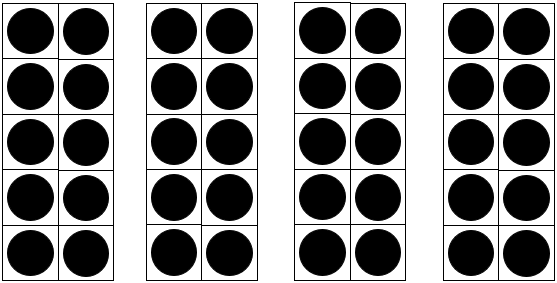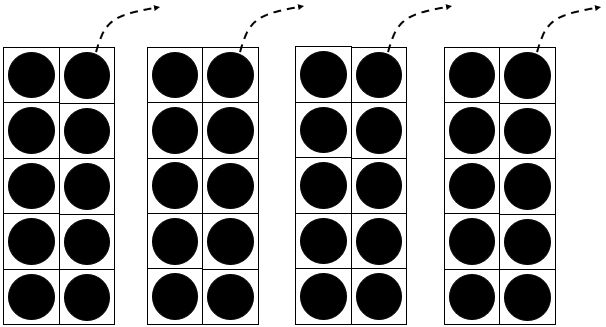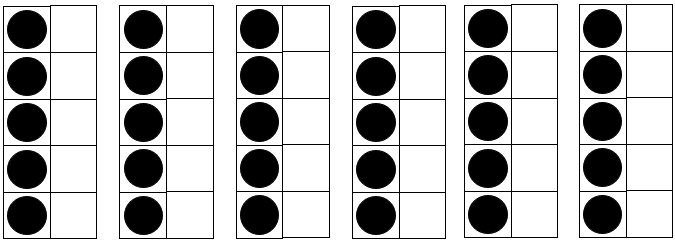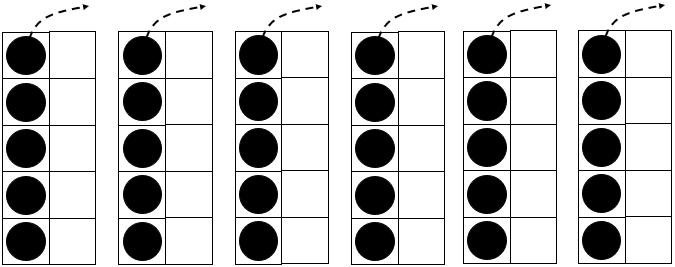The purpose of this activity is to support students deriving new multiplication facts by subtracting from known multiplication facts that involve multiples of five and ten. For example, subtracting 6 from 6 x 10 = 60 can be used to find 6 x 9 = 54.
- Tens frames (fives and tens only). Bundles of iceblock sticks (or other place value materials) grouped in tens could also be used instead of tens frames.
- Counters (preferably transparent)
- Lay out four frames with ten dots on each. Discuss the frames as a class.
How many frames are there?
How many dots are on each frame?
What is the total number of dots?
What is the multiplication equation for this? (4 x 10 = 40 - write this next to the frames).
- Ask students to cover all the dots with counters.
I know 4 x 10 = 40. How can I change the picture, so it shows 4 x 9?
Students might suggest removing one counter from each frame so there are four frames with nine counters each.
If we change this to 4 x 9, how many counters will be there in total?
Ideally students will calculate 40 – 4 = 36 using their place value and facts for ten knowledge. Remove four counters to show that 40 – 4 = 36 is the product of 4 x 9.
- Pose similar problems starting with different multiples of ten and considering multiplicands of both nine and eight. Encourage students to anticipate the result using their addition strategies before acting with materials. Consider what groupings (e.g. as a whole class, paired, working individually) will best support your students' work on these problems. Consider also how students might use different means of action and expression to display their thinking (e.g. written equations, physically moving materials, verbal explanations).
Good examples might be:- 8 x 10 = 80 so 8 x 9 = ?
- 3 x 10 = 30 so 3 x 9 = ? and 3 x 8 = ?
- 5 x 10 = 50 so 5 x 9 = ? and 5 x 8 = ?
- 9 x 10 = 90 so 9 x 9 = ? and 9 x 8 = ?
- Progress to multiples of five. Five facts are less easily learned so students may use skip counting to find the starting product. Encourage students to notice that groupings of two fives make ten, so they can apply their place value knowledge.
- Lay out six frames with five dots in each frame. Discuss the frames as a class.
How many frames are there?
How many dots are on each frame?
What is the total number of dots? (Group the fives frames to make three tens)
What is the multiplication equation for this? (6 x 5 = 30 - write this next to the frames).
- Ask students to cover all the dots with counters.
I know 6 x 5 = 30. How can I change the picture, so it shows 6 x 4?
Students might suggest removing one counter from each frame so there are six frames with four counters each.
If we change this to 6 x 4, how many counters will be there in total?
Ideally students will calculate 30 – 6 = 24 using their place value and facts for ten knowledge. Remove six counters to show that 30 – 6 = 24 is the product of 6 x 4.
- Pose similar problems starting with different multiples of five and considering multiplicands of both four. Encourage students to anticipate the result using their addition strategies before acting with materials.
Good examples might be:- 8 x 5 = 40 so 8 x 4 = ?
- 5 x 5 = 25 so 5 x 4 = ?
- 7 x 5 = 25 so 7 x 4 = ?
- 9 x 5 = 45 so 9 x 4 = ?
- Provide the students with opportunities to practice deriving from multiples of ten and five by subtraction. Give the students a known multiplication fact then provide a different fact that is easily derived.
Good examples are:
7 x 10 = 70 so 7 x 9 = ? 5 x 10 = 50 so 5 x 8 = ? 9 x 10 = 90 so 9 x 9 = ?
4 x 5 = 20 so 4 x 4 = ? 8 x 5 = 40 so 8 x 4 = ? 7 x 5 = 35 so 7 x 4 = ?
Next steps
- Provide contexts in which students can apply their deriving strategies. These could be linked to students' interests, cultural backgrounds, or to relevant learning from other curriculum areas.
For example, “I have 8 packets of Mallowpuffs. Each packet has 10 Mallowpuffs. How many Mallowpuffs do I have? How can I write this an equation? If I eat one biscuit from each packet, how many Mallowpuffs do I have left? How many will I have if I eat two Mallowpuffs from each packet"
As students work through these deriving problems, encourage them to represent the situations using written equations and materials, if needed.
- Act out deriving from multiples of ten and five using finger patterns.
For example, ask four students to hold up ten fingers each.
Change the four sets of ten into four sets of nine.
How many fingers do we have in total now?
Use similar examples, deriving from multiples of five.
For example, ask six students to hold up five fingers each.

Change the six sets of five into six sets of four.
How many fingers do we have in total now?